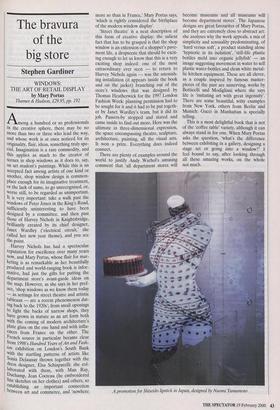The bravura of the big store
Stephen Gardiner
WINDOWS: THE ART OF RETAIL DISPLAY by Mary Portas Thames & Hudson, £29.95, pp. 192 Anong a hundred or so professionals in the creative sphere, there may be no more than two or three who lead the way, and whose work is at once noticed for its originality, flair, ideas, something truly spe- cial. Imagination is a rare commodity, and this applies as much to the creator of scenes in shop windows as it does to, say, an art student's paintings. While this is an accepted fact among artists of one kind or another, shop window design is common- place enough for its imaginative treatment, or the lack of same, to go unrecognised, or, worse still, to be regarded as unimportant. It is very important: take a walk past the windows of Peter Jones in the King's Road, sufficiently uninteresting to have been designed by a committee, and then past those of Harvey Nichols in Knightsbridge, brilliantly created by its chief designer, Janet Wardley (`electrical circuit,' she called her new year theme), and you see the point.
Harvey Nichols has had a spectacular reputation for excellence over many years now, and Mary Portas, whose flair for mar- keting is as remarkable as her beautifully produced and world-ranging book is infor- mative, had just the gifts for putting the department store's avant-garde ideas on the map. However, as she says in her pref- ace, 'shop windows as we know them today — as settings for street theatre and artistic tableaux — are a recent phenomenon dat- ing back to the 1920s'; from small openings to light the backs of narrow shops, they have grown in stature as an art form both with the coming of modern architecture's plate glass on the one hand and with influ- ences from France on the other. The French source in particular became clear from 1998's Hundred Years of Art and Fash- ion exhibition on London's South Bank with the startling patterns, of artists like Sonia Delaunay thrown together with the dress designer, Elsa Schiaparelli: she col- laborated with them, with Man Ray, Duchamp, Jean Cocteau (he embroidered line sketches on her clothes) and others, so establishing an important connection between art and commerce, and 'nowhere more so than in France,' Mary Portas says, `which is rightly considered the birthplace of the modern window display'.
`Street theatre' is a neat description of this form of creative display: the salient fact that has to be grasped is that the shop window is an extension of a shopper's pave- ment life, a dropscene that should be excit- ing enough to let us know that this is a very exciting shop indeed: one of the most extraordinary ever seen — to return to Harvey Nichols again — was the astonish- ing installation (it appears inside the book and on the jacket) branching out of the store's windows that was designed by Thomas Heatherwick for the 1997 London Fashion Week: planning permission had to be sought for it and it had to be put togeth- er by Janet Wardley's team, but it did its job. Passers-by stopped and stared and came inside to find out more. Here was the ultimate in three-dimensional expression, the space encompassing theatre, sculpture, architecture, painting, all the visual arts. It won a prize. Everything does indeed connect.
There are plenty of examples 'around the world to justify Andy Warhol's amusing comment that 'all department stores will become museums and all museums will become department stores'. The Japanese designs are great favourites of Mary Portas, and they are extremely close to abstract art: she analyses why the work appeals, a mix of simplicity and sensuality predominating, of `hard versus soft', a product standing alone `hypnotic in its isolation', 'still-life plastic bottles meld into organic jellyfish' — an image suggesting movement in water to sell plastic water-bottles and clean white metal- lic kitchen equipment. These are all clever, as a couple inspired by famous master- pieces of the past are unnerving, works by Botticelli and Modigliani where she says life is 'imitating art with great ingenuity'. There are some beautiful, witty examples from New York, others from Berlin and Munich: Gucci in Manhattan is specially telling.
This is a most delightful book that is not of the 'coffee table' variety, although it can always stand in for one. When Mary Portas asks the question, 'what's the difference between exhibiting in a gallery, designing a stage set or going into a window?' I feel bound to say, after looking through all these amazing works, on the whole not much.
A promotion for Shiseido lipstick in Japan, designed by Naomi Yamamoto


































































 Previous page
Previous page